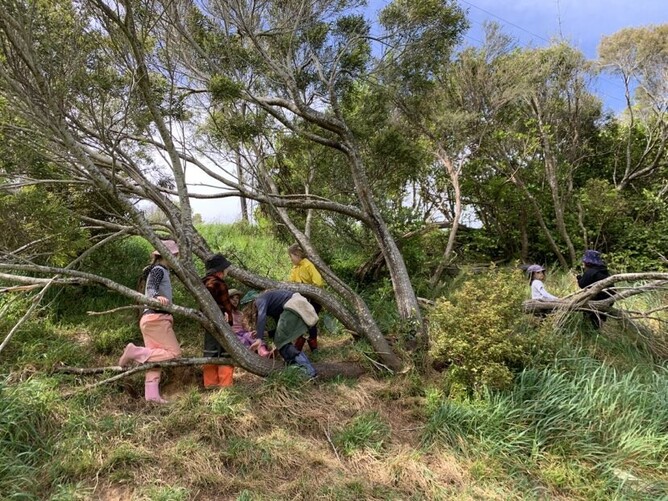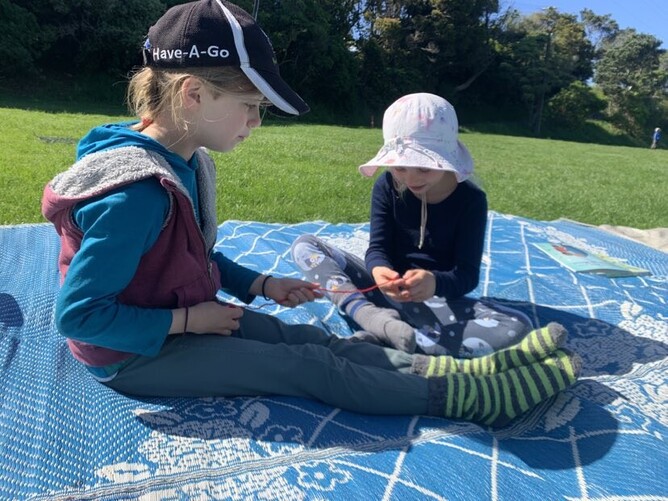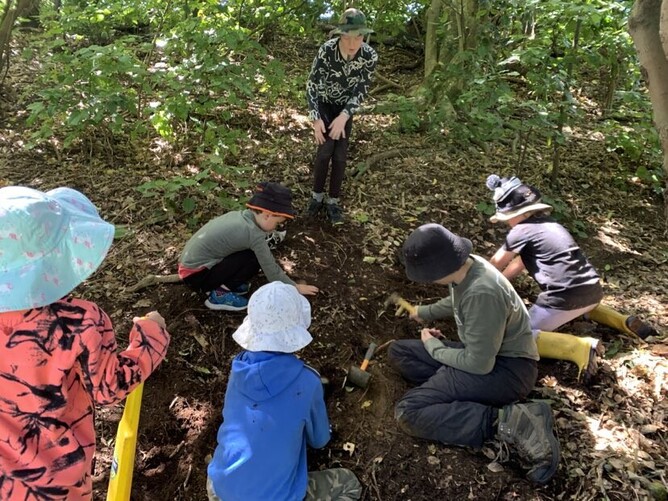10 year old helping a 6 year old to get on the swing they made together.
Parent Guilt and Play
This morning, over my breakfast scroll through social media, I came across a letter by Peter Gray that really struck a chord with me. I am that ‘guilty’ mum who struggles to sit down and engage in a tea party with my tamariki (children) for more than five minutes. It's even harder when I'm at home, surrounded by the pile of unfolded laundry or the long list of things I need to get done. I’m much better at playing when I’m outside my own house because I don’t feel the weight of other tasks looming over me.
Although, on reflection, I was definitely one of those parents at Playcentre who would set up resources (or "provocations," as the one who are good at edgy speak say) and then back away once the tamariki were fully engaged in their play. I’d find something else that needed doing or someone who needed something. It wasn’t until the lockdowns, with all that extra time at home, that I discovered just how much I didn’t like playing for long stretches with my tamariki. But I realized I needed to - to fill that playmate void. Fortunately, having three tamariki meant the void wasn’t too big. The void wouldn’t have been as manageable if I’d had just one child. Don’t get me wrong I loved many parts of lockdown - just not the ‘playmate’ part.
During that time, my youngest, who was three, loved little character games involving figures and animals. They’d move around the floor, over blocks, around other toys, saying hello to each other, she would feed them pretend food, etc. It was, frankly, mind-numbingly boring for me! But one day I discovered that I could happily be the playmate she needed—if I occupied my brain with a podcast. I’d pop in one earbud and happily move the characters from the 'shop' to the 'farm', adding in the occasional "yum, yum" or "hello." It was a win-win!
Unfortunately, this trick doesn’t work with older kids. Their games are more complex, and they can easily tell when you’re not fully invested in the game. But there are games I do enjoy. I love a good board game. Recently, I’ve been playing Pictionary with my now 12-year-old, which we both find fun. I think it’s because we think in a similar way, and I love it when he can guess the right answer from my mess of scribbles on the page. Like Peter Gray, I also love “being a monster chasing a child around pretending I’m going to catch her and eat her for dinner.” There’s a fine line between being just scary enough and too scary.
I think there's an element of "risky play" there, where the stakes feel high at the moment, but it’s all in good fun. A bit like when my husband and I were in our 20s—before kids—when we would surprise each other with pranks. It wasn’t much, just a jump out from behind a door or hiding around a corner. And now, as adults, we see similar pranks all over social media, like the rubber snake tied to someone's foot with a fishing line. Silly, sure, but still an example of play that can bridge the gap between adults and kids.
Building on Peter Gray’s Article: The Role of Peers in Play
At Everyone Out one of the most beautiful aspects is that we create an environment where tamariki can engage with each other without needing constant adult involvement. They don't require us adults to be their playmates all the time. In fact, when I observe the tamariki absorbed in their play, it becomes clear that what they need most is time to connect with their peers—others who are close to their own age. As Peter Gray pointed out in his article, play among peers is not just about fun but is essential for developing social, emotional, and cognitive skills. When I use the word peer here I don’t mean another child in the same year group or exactly the same age. I mean another child who could be several years older or younger rather than an adult.
Recently, I came across a thought (though I can't remember exactly where I read it) that I agree with: If you, as a kaiako (educator), parent, or anyone working in a play-based environment, feel a little redundant at times, it’s actually a sign that you’re doing something right. When tamariki are deeply engaged in their play and need minimal adult intervention, it’s a sign that the environment you’ve created is fulfilling their needs. At Everyone Out, this is what I see happening all the time—the tamariki are so engaged in their peer-driven play that they don’t require adults to step in and guide them constantly. And that's the goal.
7 year old teaching a 6 year old how to finger knit.
Expanding Play for All Ages
However, it’s hard to ignore the fact that society has changed dramatically in just a generation or two. Families are smaller, and we often live far from extended family, so tamariki don’t get the same opportunities to interact and play with cousins or other children across a wide age range. It’s no longer the norm for neighborhood kids to roam freely together after school, as it once was. Instead, they are often isolated or confined to structured activities, with fewer opportunities for spontaneous, unstructured play.
Peter Gray highlights this shift in his article, pointing out how children’s natural, unsupervised play opportunities have diminished in our modern, Westernized society. At Everyone Out, we try to push back against this trend by creating an environment where tamariki of all ages can play together. We provide a space where children of different ages can mix and interact, which allows them to learn from one another, experiment with different play styles, and build social skills in ways that are much harder to do when they're restricted to playing only with kids of their own age.
At our holiday programmes our rangatahi (youth volunteers) and junior educators who are closer in age to the tamariki. They are fantastic playmates and manage to find ways of including everyone, regardless of age. They often find the right balance between challenging the tamariki to play more complex games, while still keeping things fun for everyone involved.
At Everyone Out, we do not always engage directly in the children’s play; instead, we focus on creating opportunities for meaningful play experiences with their peers. Our goal is to ensure that they have the freedom and space to interact with others in ways that support their growth and development, without the overbearing influence of adult supervision.
I’ve come to realize that it’s not my job, as a parent or kaiako to be a playmate for tamariki, it’s my job to make sure they have the opportunity to play by providing the space, the resources, and the freedom to engage with each other. By focusing on their peer relationships, we give them the chance to develop the skills they need to thrive socially and emotionally. As adults, our role is to step back and support, not to control or dominate their play, and to be mindful of the fact that our society’s changes have made it harder for tamariki to interact freely across ages. At Everyone Out, we aim to create a space where that natural, peer-led play can flourish.
Mixed age peer play - tamariki aged 6 to 12 years old, boys and girls.




